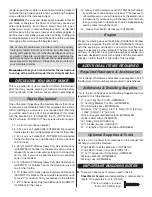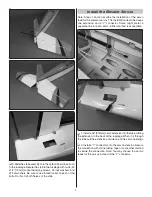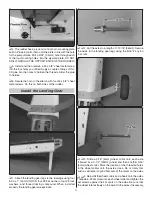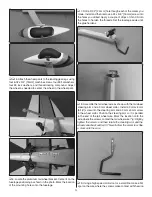
3
range is used, the modeler is responsible for taking steps to
reinforce the high stress points and/or substituting hardware
more suitable for the increased stress.
7.
WARNING:
The cowl and wheel pants included in this kit
are made of fi berglass, the fi bers of which may cause eye,
skin and respiratory tract irritation. Never blow into a part
(wheel pant, cowl) to remove fi berglass dust, as the dust
will blow back into your eyes. Always wear safety goggles, a
particle mask and rubber gloves when grinding, drilling and
sanding fi berglass parts. Vacuum the parts and the work area
thoroughly after working with fi berglass parts.
We, as the kit manufacturer, provide you with a top quality,
thoroughly tested kit and instructions, but ultimately the
quality and fl yability of your fi nished model depends on how
you build it; therefore, we cannot in any way guarantee the
performance of your completed model, and no representations
are expressed or implied as to the performance or safety of
your completed model.
Remember:
Take your time and follow the instructions
to end up with a well-built model that is straight and true.
DECISIONS YOU MUST MAKE
This is a partial list of items required to fi nish the Revolver
50cc that may require planning or decision making before
starting to build. Order numbers are provided in parentheses.
Radio Equipment
One of the great things about the Revolver 50cc is that it does
not require a sophisticated radio. This airplane can be fl own
with something as simple as a four channel radio. We think
you will be able to enjoy all of the capabilities of this model
with the Futaba 6 EX (FUTK6900), the 7C (FUTK7004), or
the 8 FG Super (FUTK8010). The airplane will also require:
❍
1- six (or more) channel receiver
❍
5 - 99 oz. servos. Futaba 3305 (FUTM0045) Two required
for the elevator, two for the ailerons and one for the rudder.
❍
2 - 50 oz. servos. Futaba 9001 (FUTM0075) One required
for the throttle. One is an optional servo that can be used
on the choke.
❍
2 - 36" [914mm] Pro Series Heavy Duty Servo Extensions
(HCAM2726 for Futaba) for the elevator servos. One is
required if you use a dual servo extension to connect the
servos. Two if you use a separate lead to two separate
ports in the receiver.
❍
3 - 12" [305mm] Pro Series Heavy Duty Servo Extensions
(HCAM2711 for Futaba). Two for the aileron servos and
one for the throttle.
❍
2- 12" [305mm] Pro Series Heavy Duty Servo Extensions
(HCAM2711 for Futaba). These would be required if you do
not use “Y” connectors from your receiver to the ailerons.
❍
1 - 6" Pro Series Heavy Duty Servo Extensions (HCAM2711
for Futaba) for the choke.
❍
2- Heavy Duty Dual Servo Lead (FUTM4135 for Futaba).
If you choose to use a dual servo lead or “Y” harnesses to
mix multiple servos you will need one for the elevator and
the ailerons. If you are using a 6 channel (or more) radio
then you may wish to operate each servo independently
and mix them through the radio.
❍
2 - Heavy Duty Switch Harnesses (FUTM4385)
Engine
For all of our testing we used the DLE 55 (DLEG0055). Another
good choice would be the O.S. GT55 (OSMG1555), though
with this engine you will need to cut a bit more of the cowl
away for clearance for the carburetor. The Revolver fl ies well
with any of the 50cc class gasoline engines available and
has been designed to work with engines with the carburetor
linkage on either the left or right side of the fuselage.
ADDITIONAL ITEMS REQUIRED
Required Hardware & Accessories
This is the list of hardware and accessories required to fi nish
the Revolver. Order numbers are provided in parentheses.
Adhesives & Building Supplies
This is the list of Adhesives and Building Supplies that are
required to fi nish the Revolver.
❍
1/2 oz. [15g] Thin Pro CA (GPMR6001)
❍
1 oz. [30g] Medium Pro CA+ (GPMR6008)
❍
Pro 6-minute epoxy (GPMR6045)
❍
Drill bits: 1/16" [1.6mm], 3/32" [2.4mm], 3/16" [4.8mm],
13/64" [5.2mm], 1/4" [6.4mm].
❍
Stick-on segmented lead weights (GPMQ4485)
❍
Silver solder w/fl ux (STAR2000)
❍
#1 Hobby knife (HCAR0105)
❍
#11 blades (5-pack, HCAR0211)
❍
2 - 3' lengths of Tygon Fuel Tube (DUBQ0486)
Optional Supplies & Tools
Here is a list of optional tools mentioned in the manual that
will help you build the Revolver.
❍
Top Flite MonoKote sealing iron (TOPR2100)
❍
Top Flite Hot Sock iron cover (TOPR2175)
❍
4 oz. [113g] aerosol CA activator (GPMR634)
❍
Mixing sticks (50, GPMR8055)
❍
Mixing cups (GPMR8056)
IMPORTANT BUILDING NOTES
●
There are three types of screws used in this kit:
Sheet Metal Screws
are designated by a number and a
length. For example #6
3/4" [19mm].
This is a number six screw
that is 3/4" [19mm] long.
Summary of Contents for Revolver 50cc
Page 32: ...GPMA1425 Mnl...




































